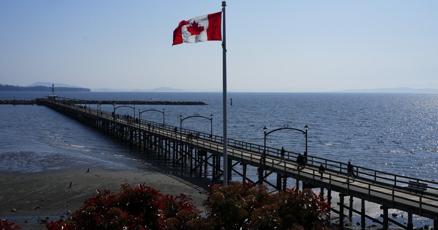I’ve spent the past week tracing the escalation points that have defined U.S.-Canada trade relations during the Trump administration. Standing at the U.S.-Canadian border crossing at Peace Arch last Tuesday, I watched trucks idling in longer-than-usual inspection lines – a visual reminder of how diplomatic tensions translate into real economic friction.
The relationship between these historic allies has weathered diplomatic storms before, but the systematic trade confrontations initiated since 2017 represent something different – what one Canadian diplomat described to me as “managed hostility with occasional ceasefire periods.”
The roots of this conflict emerged early in Trump’s presidency. In April 2017, after visiting Wisconsin dairy country, Trump targeted Canada’s supply management system for dairy, calling it “a disgrace” and “unfair.” Canadian Foreign Minister Chrystia Freeland countered in our Brussels interview that “Canada’s dairy system provides fair prices for farmers without government subsidies – unlike the American approach.”
By January 2018, the first concrete actions materialized when the U.S. imposed tariffs on Canadian softwood lumber of up to 24%. The Commerce Department claimed Canadian lumber was unfairly subsidized, though the World Trade Organization has repeatedly ruled against similar U.S. claims in past disputes.
The conflict intensified dramatically in June 2018 when the Trump administration imposed 25% tariffs on Canadian steel and 10% on aluminum, citing “national security concerns” under Section 232 of the Trade Expansion Act. Canada exported approximately $16.6 billion in steel and aluminum to the U.S. in 2017, according to Statistics Canada.
“This is the first time since 1945 that the U.S. has labeled Canada a security threat,” explained Dr. Robert Wolfe, professor emeritus at Queen’s University, when I spoke with him in Kingston. “It fundamentally misunderstands the integrated nature of our defense industrial base.”
Canada’s response was swift and targeted. On July 1, 2018 – symbolically, Canada Day – Prime Minister Justin Trudeau announced $12.8 billion in retaliatory tariffs on American goods, carefully selecting products from politically sensitive regions. The list included steel, aluminum, coffee, yogurt, and even maple syrup.
“These aren’t just numbers on a balance sheet,” said Maria Santana, who operates a small manufacturing business in Hamilton, Ontario that I visited in August 2018. “Our material costs jumped 22% overnight. We’ve had to lay off six employees already.”
The diplomatic temperature rose further at the G7 summit in Charlevoix, Quebec in June 2018. After seemingly reaching agreement on a joint communiqué, Trump withdrew U.S. support via Twitter while departing the summit, calling Trudeau “very dishonest and weak” after the Canadian leader stated his country wouldn’t be “pushed around” on trade.
Peter Navarro, then Trump’s trade advisor, famously declared there was “a special place in hell” for Trudeau. The comment shocked many observers of U.S.-Canada relations, including former U.S. Ambassador to Canada Bruce Heyman, who told me, “This rhetoric damaged decades of careful relationship building. Some of that trust may never fully recover.”
Negotiating positions hardened throughout NAFTA renegotiations. Trump repeatedly threatened to terminate the agreement entirely, calling it “the worst trade deal ever made.” U.S. Trade Representative Robert Lighthizer demanded a sunset clause that would automatically terminate the agreement after five years unless all parties agreed to continue.
By September 30, 2018, negotiators reached agreement on the United States-Mexico-Canada Agreement (USMCA), though the steel and aluminum tariffs remained in place until May 2019.
The agreement featured several key changes from NAFTA, including greater U.S. access to Canada’s dairy market (3.6%), stronger intellectual property protections, and higher regional content requirements for automobiles (75%, up from 62.5%).
“The devil is in the details,” explained Catherine Porter, an auto parts supplier from Windsor, Ontario. “Higher regional content sounds good until you realize how complex our supply chains have become. Some components cross the border seven times during manufacturing.”
The economic impact has been measurable. According to the C.D. Howe Institute, the steel and aluminum tariffs cost Canada about $3.2 billion annually during their implementation. U.S. consumers faced higher prices on numerous goods, with studies from the Federal Reserve estimating manufacturing job losses of around 75,000 due to higher input costs.
Yet beyond economic metrics lies a deeper transformation. In diplomatic circles, Canadian officials now speak of “strategic hedging” – maintaining strong U.S. ties while actively diversifying trade relationships. The Comprehensive Economic and Trade Agreement (CETA) with the European Union and the Comprehensive and Progressive Agreement for Trans-Pacific Partnership (CPTPP) reflect this approach.
“We’ve learned we cannot take the U.S. relationship for granted,” a senior Canadian trade official told me on condition of anonymity. “Even with USMCA in place, we’re preparing contingency plans for future disruptions.”
This new wariness extends to the private sector. When I visited Toronto’s financial district in early 2020, executives described implementing “U.S. political risk committees” – something previously reserved for volatile emerging markets.
The experience has left lasting impacts on public sentiment. Polling by Nanos Research shows Canadian favorability toward the U.S. dropped to historic lows during this period, with only 37% of Canadians expressing positive views of the U.S. in 2018, down from 66% before 2017.
As Washington’s attention shifted to China and the pandemic in 2020, U.S.-Canada trade tensions receded from headlines but continue simmering in sectors like softwood lumber and dairy. The Biden administration has maintained many Trump-era policies, including “Buy American” provisions that concern Canadian exporters.
This trade conflict timeline reveals more than economic friction – it documents a fundamental recalibration of North America’s oldest and most integrated bilateral relationship. The question now is whether this represents a temporary disruption or a permanent shift in how these neighbors approach their economic partnership.






